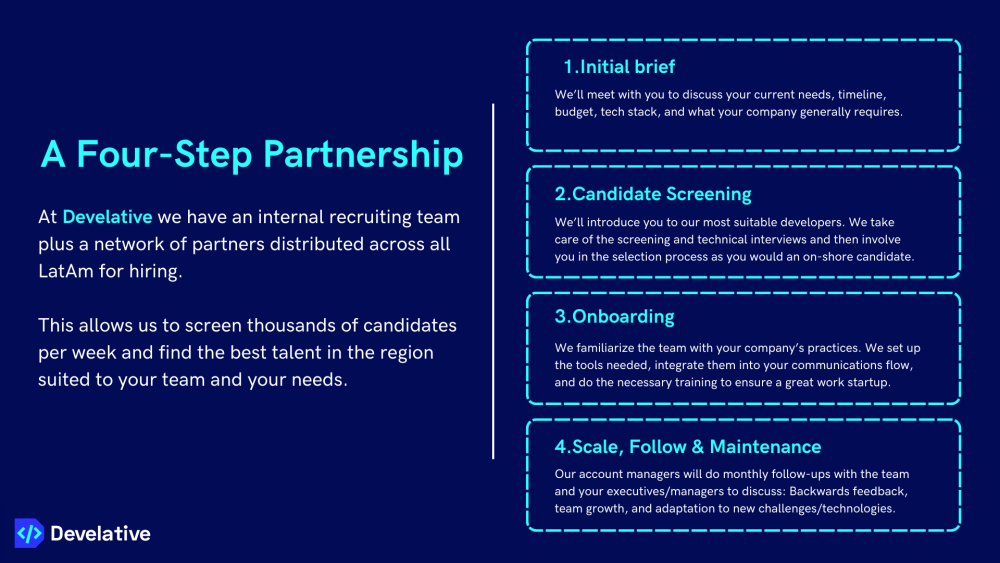
What Is And What Are The Best Countries To Look At?
Overview
Are you struggling to find the right tech talent to help your business grow? Do you want to enhance your team's capabilities without the high overhead costs of hiring full-time employees? Fasten your seatbelt because we are going to explore a great option and the best countries for it in this article.
Who We Are?

Develative is a nearshore staff augmentation company, and we specialize in connecting businesses with talented developers and engineers based in Latin America, providing you with the resources and expertise you need to meet your business goals. And the best part? We take care of all the logistics, benefits, payroll, and taxes, so you can focus on what you do best: growing your business.
What is Staff Augmentation?
Simply put, staff augmentation is the process of hiring additional staff members to augment your existing team. This approach provides businesses with the flexibility to access specialized skills and expertise on-demand, without the need to recruit and train new employees. This enables us based companies to have a remote team of engineers at their disposal, while increasing their cost savings.
According to a recent report by Deloitte, the demand for skilled technology workers is higher than ever, with nearly 80% of organizations reporting a skills gap in their workforce. With staff augmentation, businesses can bridge this gap by accessing top-tier developers and engineers from around the world. However, time zones need to be considered to get the job done, since cultural differences and language barriers could play an important factor when outsourcing software developers.
In this article, we will also explain the two most important types of outsourcing when building remote development teams, offshore outsourcing and nearshore outsourcing.
At our company, we provide businesses with access to a talented pool of developers and engineers in Latin America, who can work seamlessly with your existing team to complete projects on time and within budget. We handle all the logistics, benefits, payroll, and taxes, so you don't have to worry about any of the administrative burden.
What is Nearshore?
Nearshore is when a company hires employees from a neighboring country, often with a similar culture and timezone. For example, a US-based company might choose to work with a development center in Latin America like Mexico or Argentina. In this case, the company benefits from the proximity of the development center, which can make communication easier (since they will mostly share the same business hours) and reduce travel costs.
What is Offshore?
Offshore, on the other hand, is when a company hires employees from a country that is far away, often with a different culture and timezone. For example, a US-based company might choose to work with a development center in India. In this case, the company benefits from lower labor costs, but may face challenges related to communication, cultural differences, and time zone differences.
So, which is Better: Nearshore or Offshore?
When it comes to deciding between nearshore and offshore, there is no clear answer. Each approach has its own advantages and disadvantages, and the best choice will depend on your specific business needs.
That being said, for many companies, nearshore offers the best of both worlds. By working with a development center in a nearby country with a similar culture and timezone, companies can benefit from lower labor costs while still enjoying easy communication and reduced travel expenses.
What About Talent Retention?
Talent retention is a crucial factor to consider when working with a remote development team. As your company grows and adopts more users, it's important not only to attract great talent but also to keep it in the long run.
When you hire a remote development team from Latin America, you benefit from the fact that engineers can earn higher salaries than they might receive from local companies. As a result, remote engineers working on a contract basis tend to stay with their assigned company for longer than average. In fact, according to a survey by LinkedIn, remote engineers typically stay with their companies for an average of over 4 years. This is significantly longer than the average tenure for employees at Uber, for example.
This means that when you work with a nearshore development team, you can rest assured that talent retention is one thing less to worry about. Of course, it's important to ensure that your remote team members have a healthy work-life balance, and that you provide opportunities for professional growth and development. But by working with a development center in a nearby country with a similar culture and time zone, you can build strong relationships with your team members, and create a sense of shared purpose and commitment that will help to keep them engaged and productive for the long haul.
The Best Countries To Look For
When it comes to staff augmentation, not all countries are created equal. While there are talented developers and engineers all around the world, some countries stand out as being particularly well-suited for providing a remarkable service.
Argentina: Has a long history of producing talented software developers and engineers. The country has a strong education system and a thriving technology industry, making it an ideal location. In addition, Argentina has a favorable time zone overlap with the US, making communication and collaboration easy.
Brazil: Great location to look for, their tech talent is outstanding. The country has a large and growing technology sector, with a particular focus on mobile app development and cloud computing. Brazil also has a favorable business climate, with low costs of living and doing business.
Mexico: Mexico has become a major player in the software development outsourcing and nearshoring industry, thanks in part to its proximity to the United States. With a strong technology sector workforce, competitive salaries, and mature infrastructure, Mexico is a desirable outsourced partner for companies looking to augment their teams with top talent.
Chile: Chile's digital transformation has been accelerated by the pandemic. Many companies in the country have had to adopt new digital technologies, such as video conferencing, document sharing and cloud solutions to keep their operations running smoothly. As a result, employers have become more comfortable with remote teams, and employees have adapted to new ways of working and managing their time online from home, creating a steep learning curve.
From a population standpoint, Brazil and Argentina tend to be the best-known South American countries for software development outsourcing. The reason for this is simple: a larger base of talent means better chances of finding strong developers suited to your needs.
Frequently Misconceptions
There are some misconceptions that we'd like to clear up. One common misconception is that staff augmentation means losing control over your projects. In reality, staff augmentation provides businesses with full control over their projects, while also giving them access to additional resources and expertise.
Another misconception is that it is only suitable for short-term projects. While it's true that can be a great way to complete short-term projects on time, it can also be used to provide long-term support for your business. In fact, a recent report by HBR Consulting found that staff augmentation can be a cost-effective alternative to hiring full-time employees, allowing businesses to save money, up to a 30%.
Frequently Asked Questions
Still not sure if it is the right choice for your business? Here are some answers to frequently asked questions to help you decide:
How do I know if staff augmentation is right for my business? If you need additional resources to complete a project or require specialized skills and expertise, staff augmentation may be the right solution for your business.
How do you ensure that the staff members provided are qualified? We have a rigorous selection process to ensure that our staff members meet our high standards. We thoroughly review resumes and conduct interviews to assess technical skills, communication skills, and cultural fit.
How do you ensure that staff members work seamlessly with our existing team? We work closely with your team to understand your business needs and project requirements. We also provide ongoing support to ensure that our staff members integrate smoothly into your existing team and work culture.
At Develative, we take pride in providing businesses with access to top-tier developers and engineers in Latin America. Our services have helped businesses save time and money while enhancing their team's skills and expertise. And with our commitment to handling all the logistics, benefits, payroll, and taxes, you can focus on what you do best: growing your business.
What To Do Next?
If you reached this point in the article, you may be considering giving it a shot, but in order to ensure success when adding external members to your team, you need to consider the following items (as mentioned in this blog post):
Here's a quick list of the most important points to consider:
Clearly Define Your Needs
Clearly define the types of positions you need to fill and any specific qualifications or skills required. This will help your account executive understand your needs and find the best candidates for the role you're looking to fill.
No Radio Silence, Communicate Often
Maintaining open lines of communication through email, Slack, Discord, or any other communication tool is key, this will keep requirements up-to-date and the staffing firm informed of your needs. We know it's hard, but it is key to succeed.
Resume review and interviews
Have your HR team review resumes and interview candidates before making a hiring decision. This will ensure that the candidates are a good fit for your company and the open position. Remember to not only screen them technically but also on cultural fit and ensuring that they match with the vibe of your current team.
Provide feedback and iterate
After each review or interview, provide feedback about the candidates. It will help the staffing firm understand your preferences and provide better candidates in the future if a match wasn't found yet. This is an iterative process that gets better with each touchpoint of feedback that you can provide.
For reference, here's an image that clearly defines what to expect and what will be required of you when working with us.

Final Thoughts!
This is the end of the post. I sincerely hope this has been of help for you whether you are just looking for information on the topic or actually considering giving it a go.
If you're interested in working with us, you can schedule a free 15' consultation call with us here.
Any feedback on this article or things that you think I've missed? Feel free to connect with me on LinkedIn. I try to be as active as I can while I push Develative further to help impactful companies in the US.
Cheers!
Sources:
Deloitte. (2021). Tech Talent for Business
HBR Consulting. (2020). Staff Augmentation and the Future of Work: Maximizing Flexibility and Control
About the author

Marcos Ocon
Marcos is the Chief Operating Officer of Develative. He's in charge of several departments and currently manages a team of +50 engineers, SDRs and HR analysts. He enjoys nature, playing golf with friends and competitive Judo.
